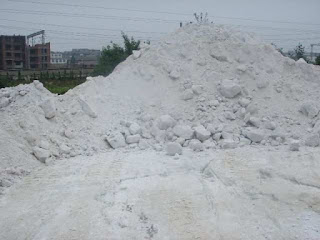PERMANENT MAGNETS
In beneficiation plant, Most of
the weakly magnetic minerals, such as garnet, ilmenite, and magnetic impurities in silica sand, can be effectively separated with a magnetic separator
that has a flux density greater than 6,000 gauss. For nearly a century,
induced-roll magnetic separators were the only economically viable unit
operation in these applications. In spite of their considerable success,
induced-roll separators have certain limitations in their selectivity and
application. The development of permanent-magnet technology during the last two
decades has reestablished the importance of magnetic separation and has
increased the efficiency of fine-particle separations that were not successful
with induced-roll magnets.
Principle and Design
In the last decade, magnetic separation technology has undergone a
revolution. Research in material science and ceramic technology has culminated
in the development of new permanent rare-earth magnets and superconducting
alloys that can be used to build high-gradient magnetic separators.
Successful adaptation of these new magnetic materials combined with the
knowledge of magnet geometry has led to the design and development of a number
of new magnetic separators. These separators have opened niche markets that
were previously considered beyond the realm of magnetic separation. These new
separators are capable of
_ Effectively removing magnetic impurities or reducing their concentration
(even to ppm levels)
_ Producing high-grade mineral separates
_ Operating on virtually no energy, which makes them economical
_ Generating higher magnetic flux levels up to 21,000 gauss or 2.1 tesla
Recent improvements in magnet composition and design have led to the
development of permanent magnetic separators. These improved rare-earth
permanent magnets (e.g., NdFeB magnets) have a magnetic attractive force an
order of magnitude greater than that of conventional permanent magnetic circuits.
The two main types of dry permanent magnetic separators that have found wide
industrial applications are the rare-earth drum (RED) and the rare-earth roll
(RER). They are widely used to separate weakly magnetic materials, such as
garnet, ilmenite, and chromite, and also to separate magnetic impurities present
in low concentrations in silica sand.
Rare-earth
Drum Separator.
In an RED separator, the NdFeB magnets are uniquely arranged to provide an
intense (up to 9,000 gauss) and “deep” magnetic field perpendicular to the drum
surface (Figure 1). Once the particles are on the drum surface, they experience
uniform flux density that minimizes the misplacement of pinned particles to the
middlings. The weakly magnetic particles pinned to the drum are carried to the
region of no magnetic intensity and are released as magnetics. The centrifugal
force of the rotating drum throws those particles not influenced by the
magnetic field into the nonmagnetic hopper.
An industrial-scale RED separator usually has three drums (Figure 2). In
general, the top drum is a low-intensity (up to 2,000 gauss) scalper magnet to
remove ferromagnetic particles, and the nonmagnetic fraction is subsequently
treated on the REDs. The main purpose of the scalper is to protect the bottom
two REDs, as well as to increase their capacity. Some separators have a
built-in internal aircooling system to protect the magnets from overheating
when the feedstock is preheated, as in plants that process beach and silica
sand.
Rare-earth
Roll Separator.
The feed is fed onto a thin belt (usually 7.6 × 10–3 to 5.1 × 10–2 cm) that travels at a very high
velocity. The unique aspect of these separators is the way in which the magnetic separator is configured as a
head pulley. The feed material is passed through the magnetic field, and the
magnetic (or weakly magnetic) particles are attached to the roll and separated
from the nonmagnetic stream (Figure 3).
Drum separators can effectively handle coarse particles (12.5–0.075
mm), whereas roll separators are very effective in treating fine particles
(<1 mm). The capacity of the deeper-field drum separators is generally
higher than that of the roll separators at 400–500 lb/h/in. for drum separators but 100–300
lb/h/in. for roll separators. The major advantage of the drum separator is its
low maintenance cost, because it does not contain a belt that must be replaced
frequently. However, both separators have their own niche markets. Drum
separators can treat coarser particles, such as garnet, ilmenite, and iron ore,
at a higher throughput. Roll separators can be used in producing high-grade, high-purity
glass sand products when the feed material is not preheated.
Eddy
Current Separator.
In the case of the RED and RER magnetic separators, the outer drum or the
belt rotates, while inside the shell, rare-earth magnets are mounted on a
stator. However, in an eddy current separator not only does the nonmetallic
outer drum rotate but also the inside shell, which is a faster-moving rotor
containing rare-earth magnets arranged in alternating polarity to produce
induced eddy currents. The induced eddy current sets up a repulsive force in
good conductors and thus separates nonferrous electrically conductive metals,
such as copper and aluminum, from nonconducting materials.
Wet Permanent Magnetic Separator
A wet permanent magnetic separator is shown in Figure 4.
The permanent-magnet (NdFeB) bars are positioned more or less horizontally
inside a revolving drum made of stainless steel. This separator provides a
field strength of 0.7 tesla on the drum surface. The pulp tank is made of stainless
steel with concurrent or semicountercurrent flow tank design and an adjustable
discharge gap at the magnetics discharge end. The separator is equipped with an
adjustable valve on the nonmagnetics discharge pipe. This valve helps to
control the flow rate and overflow level. It has found industrial applications
in processing low-grade (martitic) iron ore.





评论
发表评论